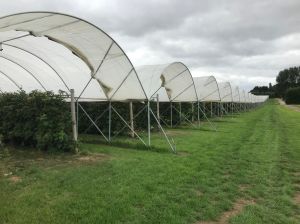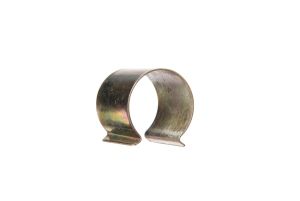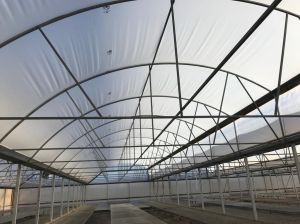Cut-to-size polyethylene foil, fast delivery!
You can find tunnel film and greenhouse film in all shapes and sizes. But for crop development, it is very important which type of polyethylene foil you choose, because many different properties can be imparted to it. Such as: thermal resistance, anti-condensation, anti-fog, anti-dust, UV stability and light transmission.
High-quality foil
FruitSecurity Holland supplies high-quality foils in the most common widths. The polyethylene foil can be used for growing soft fruit such as: strawberries, blueberries, redcurrants, raspberries, etc.
The strength of our polyethylene foil is that it has different properties to correctly influence the climate under the foil. This results in a better end result, i.e. a better fruit harvest.

Diamond®-foil
In addition to the standard types, FruitSecurity Holland also supplies Diamond® foil. The Diamond® foil is a polyethylene foil developed for more intense weather conditions. Additives are added to this foil so that the light does not shine directly on the crops. The polyethylene foil creates a unique and high light diffusion, preventing sunburn and 'shadow' effect.
Diamond® foil also increases photosynthetic efficiency: light diffusion allows light to come from all sides.
Lengths and widths of polyethylene foilFruitSecurity Holland supplies polyethylene foil in various thicknesses, widths and lengths.
|  |
| | High-quality tunnel filmWhy is the right tunnel film so important? In this video, for example, just look at the difference between new and old tunnel films. |
Light transmission
An important property of polyethylene foil is its light transmission, also known as light diffusion.
Diffuse light reduces shadows and provides the plant with a better distributed light during the day. This allows the plant to get more light from the PAR range of the light spectrum, both for the upper leaves and the lower leaves. Thus, more photosynthesis takes place. Maximum PAR range transmittance of polyethylene foil is therefore necessary.
Distribution of light
Diffuse foil distributes or diffuses light more evenly. This will greatly reduce the risk of UV stress and make the plant less susceptible to diseases. Light diffusion also produces beautifully coloured fruit, as the light reaches the fruit from all sides.

UV-stability polyethylene foil
Excessive solar radiation can damage crops, causing fruit crops to burn. FruitSecurity Holland has therefore added a UV feature to its polyethylene foil that protects the crop, as well as the foil, from ultraviolet light.
Ultraviolet light (uv) affects polyethylene foil and can even damage the foil. The foil's lifespan therefore depends on its UV resistance. To protect the foil and increase its UV resistance, UV stabilisers are added during the production process.
The uv-resistance of the polyethylene foil depends on 4 factors:
- thickness of the foil;
- light transmission or transparency;
- type of raw material;
- the use of additives such as UV stabilisers.
These factors protect the polyethylene foil from UV light.
Thermal property with EVA
The thermal property in the polyethylene foil limits heat loss in the greenhouse. The greenhouse heats up during the day through heat radiation (IR). Fruitsecurity Holland's polyethylene foil incorporates special properties that block IR radiation. This insulates the plant and creates a controlled temperature.
Thermal properties have been added to the polyethylene foil so that the heat stays in the greenhouse and tunnel at night. This is due to the addition of EVA (ethylene-vinyl acetate). EVA also improves the elasticity of the polyethylene foil. This keeps heat radiation (infrared radiation) inside the tunnel or greenhouse up to 85%.
.jpg) |  |
Antidrip polyethylene tunnel foil
Antidrip is important to protect the crop from diseases caused by condensation. This is because water droplets also act as mirrors, reflecting light. The Antidrip property of polyethylene tunnel foil therefore ensures that the drops do not fall down onto the plants or 'stick' to the foil. Due to the Anti-drip function of the polyethylene foil the drops slide down the foil.
 |  |
Anti-dust attachment of polyethylene foil
Anti-dust is used to help dust and sand slide off the foil. Antistof also reduces the risk of algae growth on the foil. The result is longer light transmission over its lifetime. In addition, a smooth foil surface makes cleaning polyethylene foil much easier.
Antimist polyethylene foil
In some parts of the world where there are large differences between day and night temperatures, fogging can occur on the foil in the morning.
The Antimist additive in FruitSecurity Holland's foil absorbs the fog to the foil and the anti-condensation layer. The anti-condensation layer then allows the condensation to run down as a layer of water.
UV-open polyethylene foil
A UV-open polyethylene foil allows the UV radiation reaching the earth's surface to pass through unfiltered. Opening the uv range from 320nm, it is needed to develop Anthocyanin pigments (red) in bi-coloured roses, nectarines and red-leaved lettuce. Anthocyanin pigment needs UV light to give colour. Anthocyanin gives the purple colour to certain lettuces and aubergines. A foil with UV filter causes colouring problems in these crops. A UV-open polyethylene foil should therefore be used. FruitSecurity Holland checks which foil is most suitable for each crop.
Laser
 In this photo, you can clearly see the type of polyethylene foil in which the light is diffused. The light diffusion reduces the shadow of the tunnel structure and the crop itself, allowing the crop to use the light optimally for photosynthesis.
In this photo, you can clearly see the type of polyethylene foil in which the light is diffused. The light diffusion reduces the shadow of the tunnel structure and the crop itself, allowing the crop to use the light optimally for photosynthesis.
Light as nutrition
Just as people need nutrition, so do plants. The quality of light is as important as the quantity. The human eye has peak sensitivity in the yellow-green region. Plants respond more effectively to red and blue light.
Humans get the most efficient calories from fat, red light provides the most efficient food for plants. It is therefore important which polythene foil you choose for cultivation.
Who we are
Meet the team at FruitSecurity Holland. You can reach us in any way you like.
What we are proud of:
|
367 Turnkey solutions since 2013 |
Represented in 24 countries |
More then 6.500.000m2 protected |






















.png)
